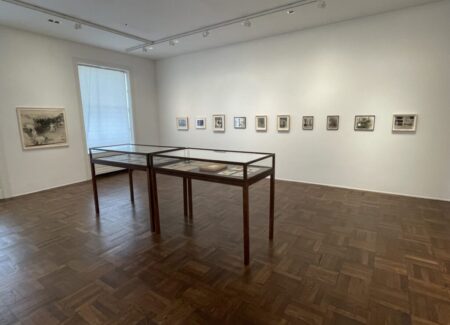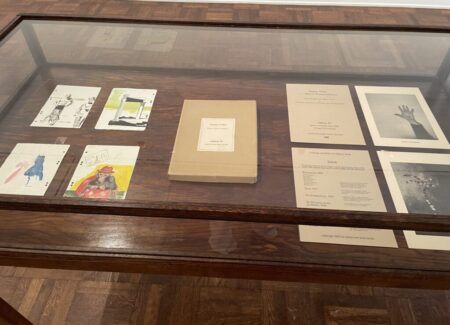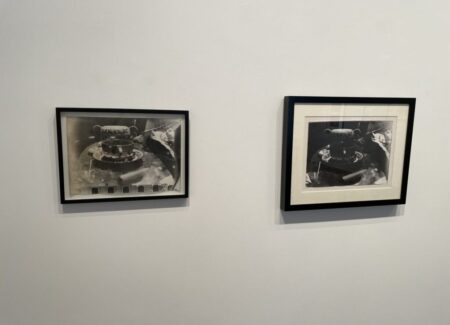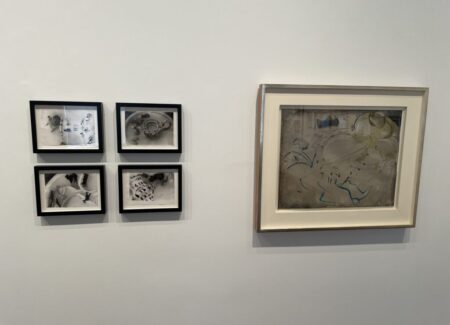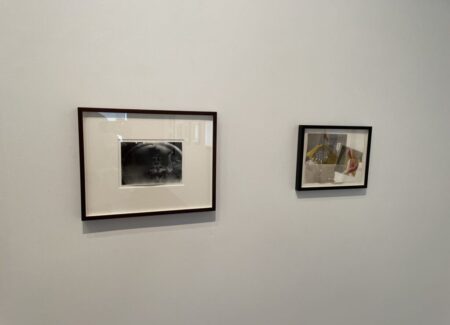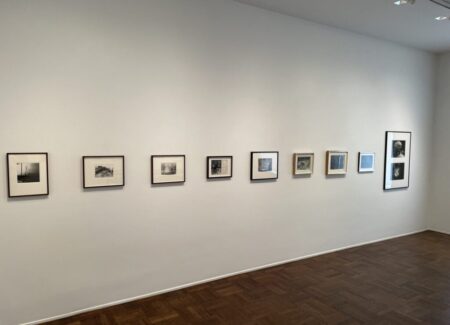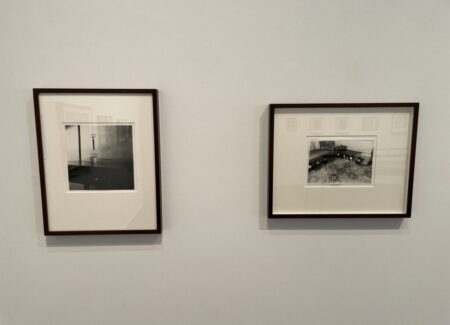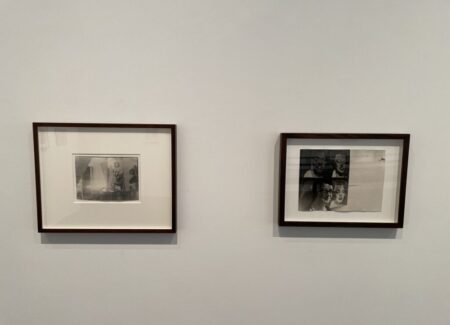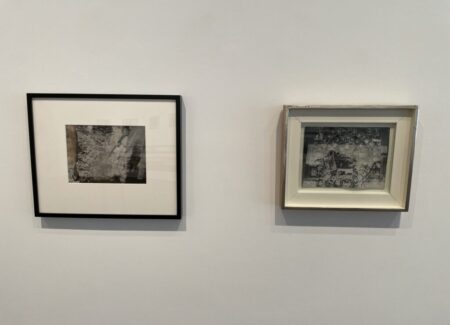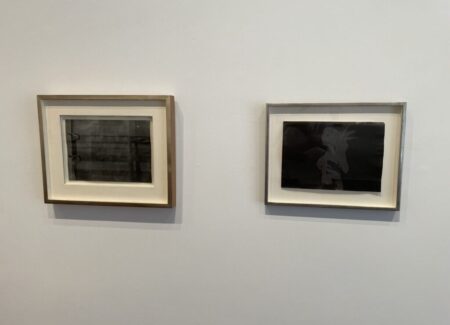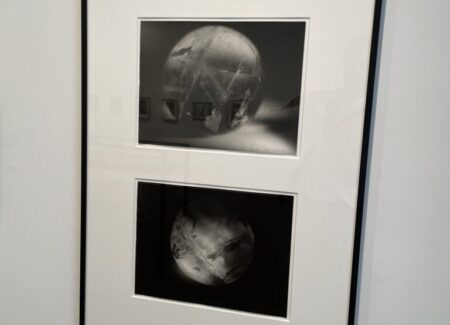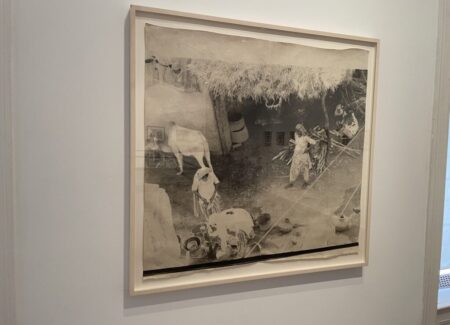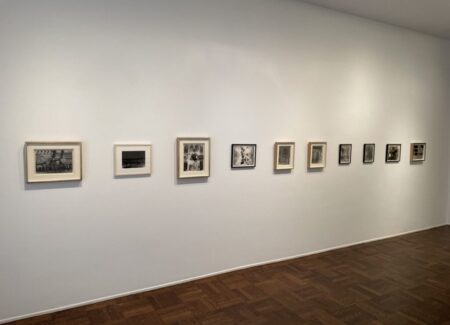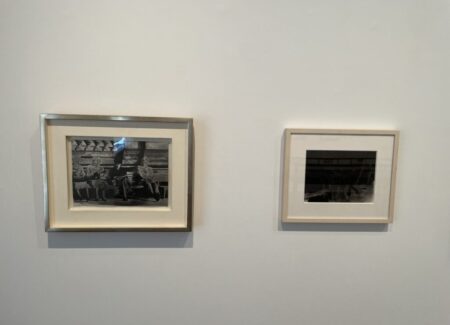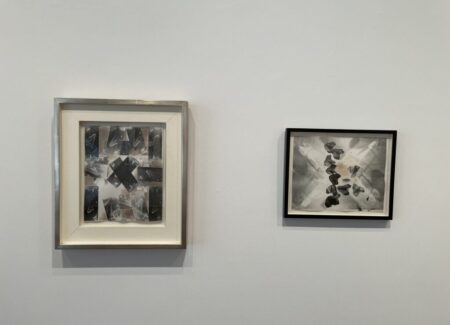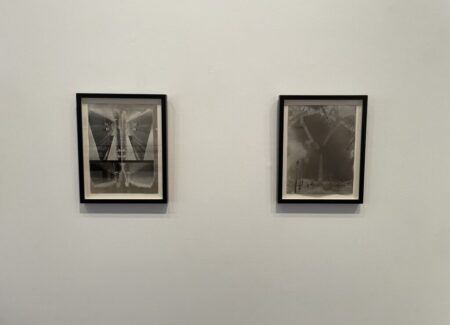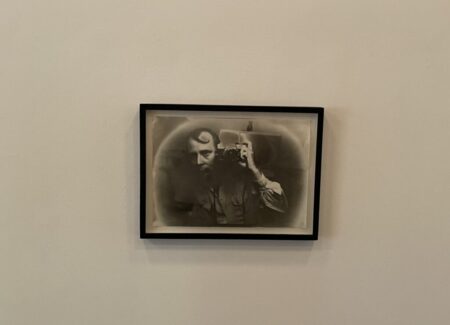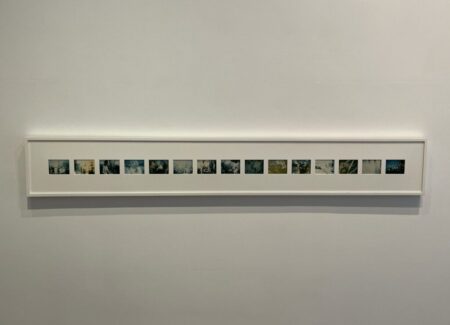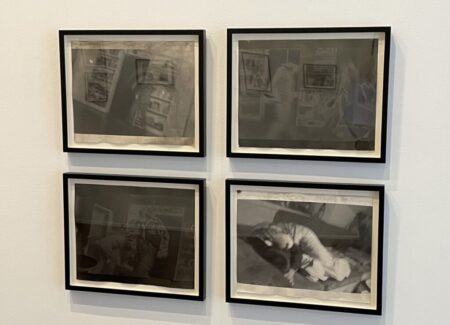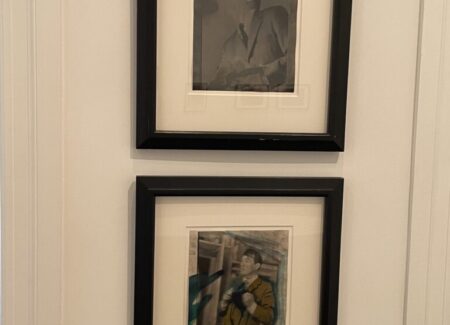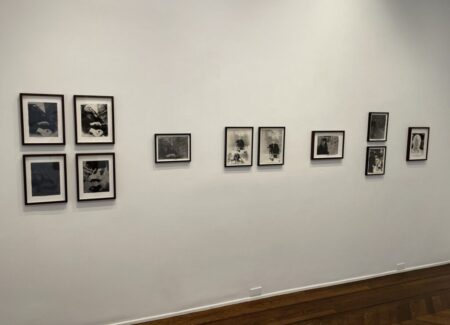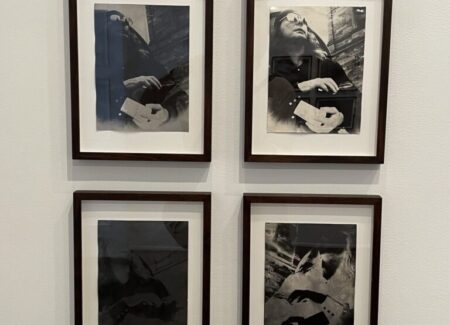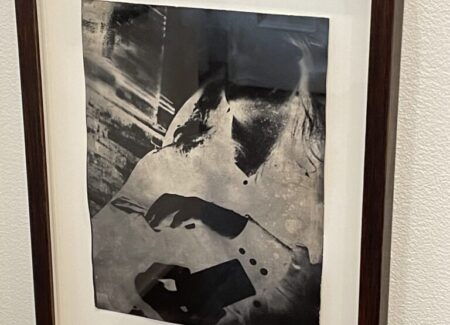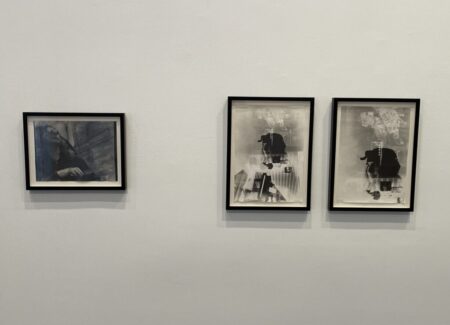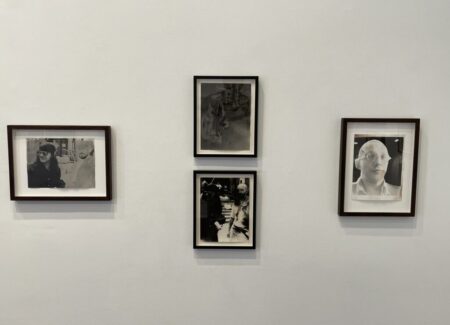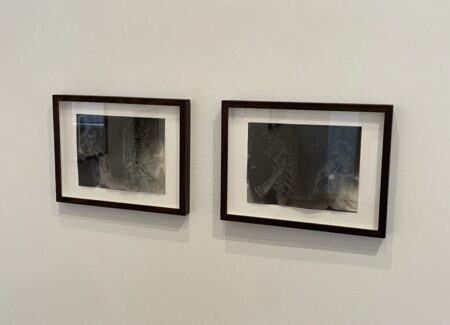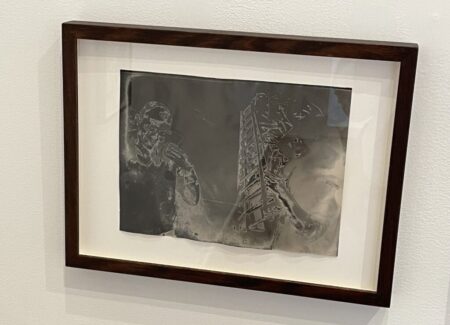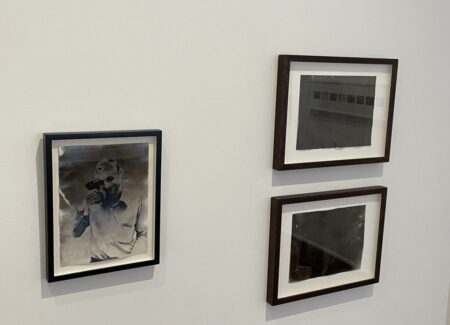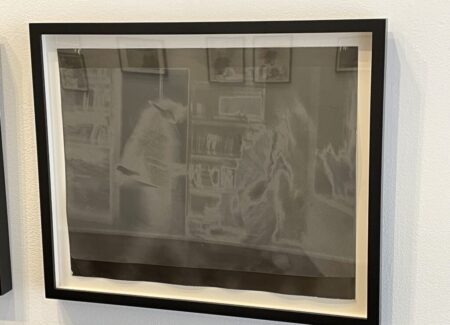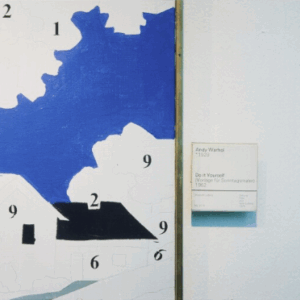JTF (just the facts): A total of 51 photographic works, variously framed and matted, and hung against white walls in the front and back gallery spaces and the connecting hallway. (Installation shots below.)
The following works are included in the show:
- (vitrine) 1 set of 14 lithographs, 4 gouaches, and 2 title sheets, with box, 1967-1968, sized roughly 12×8 inches, in an edition of 50
- 43 gelatin silver prints, c1965, 1968, 1971, c1971-1972, 1972, c1972, 1974, 1975, c1978, sized 5×7, 7×7, 7×9, 7×10, 8×10, 8×12, 9×7, 9×12, 10×7, 10×12, 12×8, 12×10, 32×33 inches
- 1 set of 4 gelatin silver prints, 1968, each sized 5×7 inches
- 1 set of 2 gelatin silver prints, 1990, each sized roughly 12×16 inches
- 4 hand-painted gelatin silver prints, 1968/1982, 1971, c1971-1972, 1974, sized roughly 7×10, 10×12, 12×10, 16×20 inches
- 1 gelatin silver print with pen and ink, 1972, sized roughly 9×12 inches
- 1 set of 15 Polaroids, 1968, each sized 3×4 inches
Comments/Context: Sigmar Polke’s early experiments with photography from the late 1960s and 1970s are generally dark and murky, often to the point that we can’t quite discern what’s actually going on. Liberally using solarization, tonal reversal, negative manipulation, chemical washes, montage, multiple exposures, overpainting, deliberate blurring, and other even less identifiable techniques, the German artist was constantly breaking down the boundaries of photography as a documentary medium, transforming even the most mundane subjects into swirlingly surreal moods, flares, and impressions.
Polke’s complex use of photography, as a small part of a much wider ranging and risk taking artistic practice, continues to be under known and appreciated. This is the first gallery show of his photographs in New York in more than a decade, reaching back to his broader MoMA retrospective in 2014 and a gallery show of his photocopy works that same year (reviewed here); the last institutional survey of his photography here in the United States was in the mid 1990s. Given Polke’s continued exploration of photographic effects in his later career, from his painterly abstractions using light sensitive silver chemicals (in the early 1990s) to his lens paintings and their lenticular distortions (in the mid 2000s), we’re certainly due for a fuller re-evaluation of Polke and his evolving interests in photography.
A 1975 Polke photograph feels like a good place to jump into this show. It’s a straightforward picture of a newspaper or magazine article placed in a ring binder; the title of the article is “Wenn Bilder Verdutten” (or “When Pictures Vanish” or perhaps when pictures become confused, depending on your preferred translation), and the image is deeply dark, so that the viewer has to get right up close to even see the reproduced page. In this way, the photograph is a conceptual nesting doll, where the picture of the article is itself vanishing or nearly illegible, and the documentary imperative of photography is being deliberately rejected.
Polke’s more conceptual bent towards photography is even more evident in a portfolio of images he made in the late 1960s (as seen in a vitrine in the center of the front gallery.) Titled “…Höhere Wesen befehlen” (or …Higher Beings Command), it finds Polke loosely playing with upright forms that look like palm trees: an extended hand, an arrangement of buttons, a wrinkled cloth, some stacked glasses, a glove, some cotton, a pair of balloons, some weeds, and even a folded measuring stick. The set of images has a Dada feel, of seeing everyday found objects with an unexpected eye, and given their time period, the photographs certainly prefigure the larger movement toward photoconceptualism that would take place in the 1970s. Other nearby images continue this kind of visual play, with scissors hovering above a glass of water, vinyl records arranged to echo the patterns of a carpet, and a series of studies of a Meissen teapot submerged in a milky basin.
Many of the strongest photographic works in the show are Polke’s early 1970s montages, many of which feature images made in Paris. In these works, Polke is experimenting on the edge of chance and control, working in the darkroom to layer and rotate negatives, add solarizations, and create unexpected compositions. One montage features a woman and a beer glass, with a single exposure multiplied out more than a dozen times, creating a zig zag effect. Other standout montages mix a repeated image of a ghostly woman in a raincoat with a scorpion motif, street views flipped and mirrored, and a picture of the obelisk in the Place de la Concorde triple rotated like the hands of a clock. Another montage then pushes even one step further, adding hand-painted colorings to an unbalanced grid of Paris scenes, playing with the geometries and adding what looks like the orb of an eye hovering above.
The rest of the show jumps from one experimental technique to the next. Polke blurs and solarizes people sitting on a park bench, and then goes even darker in a solarized image of an Indian. He explores reflected distortions in a pair of images of a crystal ball, a photography storefront in Afghanistan (with layers of arranged pictures within the picture), and his own self-portrait, perhaps made in a mirror. The entire back room of the exhibit is devoted to candids of artists using similar techniques, with the faces of Günter Brus, George Baselitz, James Lee Byars, and Gilbert & George pushed to extremes of darkness, blur, inversion, and ghostly warp. Multiple exposures enliven an image of Byars combined with handfuls of currency, and overpainting adds splashes of color to Gilbert holding a camera, with Polke iterating on some of the compositions again and again.
It’s a bit hard to imagine now just how radical and experimental Polke’s painterly interventions into photography must have looked at the time. Against a backdrop of precise photographic documentation and reproducibility, Polke’s works are resolutely messy and individual, each one actively pulled somewhere beyond the normal limits of a photograph. It is this consistent sense of probing trial and error that gives these Polke photographs their durable energy – they feel right on the edge of perplexing collapse, the artist intentionally breaking the medium so he can reimagine it in his own unique way.
Collector’s POV: The works in this show range in price from $38000 to $80000. Polke’s photographic works have only been intermittently available in the secondary markets in recent years. Prices have ranged from as little as $5000 for single images to as much as nearly $1M for larger groups of prints, with most works in the five or low six figure zone.
